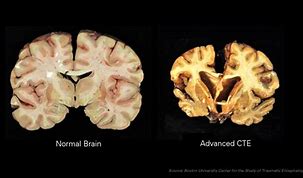Performing an autopsy on someone is like grabbing the untold stories under their skin or placing the puzzle of an unsolved death into your hands. Dr. Bennet Omalu, a Forensic Pathologist and Neuropathologist, was given an assignment at the Allegheny County coroner’s office in 2002 to examine former-NFL Pittsburg Steelers linebacker and legend Mike Webster. Omalu had never had much prior knowledge of the NFL or of the sport of football, so it became a surprise and a shock to most people when he claimed he didn’t know who Webster was.1

Omalu had no interest in watching pro football because he had already seen too many autopsies performed on NFL players, and he knew that the sport left major damages to their bodies. “There is no concept like a safe blow to the head… there’s no physician that would deny that,” said Dr. Omalu in an interview with the Physician Leadership Journal. There was never any previous set intention for Omalu to attack the NFL, or to cause conflict with them.2 What he was soon to know was that the NFL’s team of lawyers and the business itself was not something to mess with, and that they were out for blood.
Dying at the young age of fifty, eleven years after he retired from the NFL, Mike Webster’s autopsy showed that there was a noticeable amount of blemishes to the man’s body. Playing seventeen years in the NFL clearly took its toll on him; so much so that Dr. Omalu said, “If I had not been told his age, I would say he looked like 70.”3 Starting off at his cracked and misshapen feet, saying that they were “damaged” was an understatement. His family said Webster would duck tape them to suppress the damage. Stories were also told that Webster had some of his teeth fall out and instead of going to the doctor, he decided to put them back in with gorilla glue and go about his day.4
What really sprung Omalu’s interests was Webster’s receding hairline and damaged scalp. It was described as a “built up shelf of scar tissue” taken from all the head damage he had experienced in those years of football play. Omalu knew something had to have been wrong with the brain, like a serious form of dementia or something of the sort.5 He was well known for taking hits to the head, and his favorite part about football was when it was rough, muddy, and in the rain or cold. They called him “Iron Mike” as they also called the team lineup “The Steel Curtain.” In his last years, he started developing different personality traits, and wasn’t quite himself anymore. His family noticed that he became really confused when he spoke, and he also started to be less patient and more angry at simple tasks. He began living out of a pickup truck after his divorce, and couldn’t sleep for days, leading to the point to where he had a friend zap him with a taser in order for him to fall sleep.6 All this evidence left Omalu surprised when his brain didn’t have dementia or Alzheimer’s. Something wasn’t adding up. He decided to cut into the brain, and that’s when he discovered the abnormality. It was the world’s first ever confirmed case of Chronic Traumatic Encephalopathy (CTE).

CTE is a life threatening brain disorder that is caused by taking hard hits to the head consistently over a period of time. It is known to cause symptoms including confusion, forgetfulness, anger, and impulsive behavior, and it can completely change ones character. It can only be diagnosed at autopsy by scientists studying sections of the brain. There has been only a small amount of research available to scientists because of limitations of access to former athletes’ brains. These symptoms correlate to those affected having earlier death rates, and it is fatal to those who have this disease.7
Omalu decided that once he completed his report on Mike Webster, he would send it to the NFL’s Mild Traumatic Brain Committee, because he assumed it would be important information that they would probably want to have. The MTBI committee was formed by the NFL to study the science behind concussions and to understand the long-term effects of players from CTE. But instead of commending Omalu’s findings, the committee called for the paper’s retraction, disputed his published work, and began to go after his career with vengeance. Their scientists discredited all of his work, claiming that he was wrong, and saying that all of his evidence was “not scientific.”8 It would be a challenge to get the word out about the dangers of CTE because the NFL held great influence in the media. “You can’t go against the NFL; they’ll squash you,” said Omalu.
After denying Omalu’s work and discovery, they were further questioned by the media on CTE, and they proceeded to downplay any remarks made on it. They hired doctors that were biased to the NFL to respond to the questions asked by reporters about CTE. They stuck to the NFL’s claims about concussions, and said, “they are not serious injuries.” Reports even came out saying that if football athletes got diagnosed with a concussion, they could return that same game. They also denied any long-term problems from concussions sustained while playing football. They did anything they could to protect their business and not make football look like a dangerous sport. Peter Keating, a journalist, said that “the NFL has had the strategy of going nuclear any time it goes to court because the first time you ever lose, you open floodgates of potential billions of dollars at damage.”9
Years later, Neuropathologist Dr. Ann McKee took on the task of finding more cases of CTE, and out of twenty brains they examined, nineteen of them contained CTE. Some of those athletes never had a confirmed concussion in their career, so this led her group to believe that it can also be caused by sub concussive hits. These kind of hits don’t take a player out of a game, but it is this consistent amount that leaves them with this life-threating disease. “They’ll be heavily hitting their head against each other,” says Robert Stern, a Neuropathologist. “Those things seem to happen around 1000 to 1500 times a year. Each time is around 20G or more, which is the equivalent of driving a car 35 mph into a brick wall.”10
Coverage like this helped spark interest in Congress to ask why the MTBI had been taking so long to produce their research, and why they have been denying others’ research since 1994. In 2007, Representative Linda Sanchez really handed it to the NFL by stating, “The NFL reminds me of the tobacco companies pre 90’s.” The NFL immediately had to jump at fighting this claim, so the commissioner of the NFL Roger Goodell made some changes to the rule book designed to protect players from concussions. They also decided to donate to the Head’s Up program for youth athletes, and $30 million to the National Institutes of Health for them to further study this disease.11

4,500 retired NFL players also wanted to take a shot at holding the NFL accountable by filing a $2 billion lawsuit. They claimed the NFL had “fraudulently downplayed the danger to their brains.” Some of these players have suffered from dementia, depression, or Alzheimer’s due to playing football. Many report that they were rushed back into a game after having a concussion, and the NFL only wanted to profit off the players instead of getting them better first. The NFL denied any wrong doing, and insisted the top priority has always been their safety. The lawsuit ended just before the start of the 2013 season by settling with the NFL, who paid $765 million dollars to its former players.12
Omalu’s discovery opened the doors for many in the athletic community. It brought an eye-opening message to the NFL, football players and fans all across the US by exposing the dangers and long term effects. It challenged the knowledge of the NFL and called for a redirection in the values of our athletes’ health and their well being. Even though the NFL has never openly taken any responsibility for the past two decades of this disorder, Dr. Omalu and others have contributed to saving lives and to creating safer ways for athletes to play. Only time will tell what further progress can be made in understanding CTE, but once we can completely confirm that football leads to long term health problems and CTE, we can finally start taking steps in the right direction for the health of our beloved athletes.
- “Dr. Who Inspired Will Smith Film Speaks At UC Davis Commencement,” Patch (website), May 14, 2019, https://patch.com/california/davis/dr-who-inspired-will-smith-film-speaks-uc-davis-commencement. ↵
- Bill Steiger, “Meet Bennet Omalu, Md: The Physician Leader Whose Research Inspired the Movie Concussion,” Physician Leadership Journal 3, no. 2 (April 3, 2016): 8–10. ↵
- FRONTLINE PBS, Official, League of Denial (Full Film) | FRONTLINE, 2019, https://www.youtube.com/watch?v=SedClkAnclk. ↵
- FRONTLINE PBS, Official, League of Denial (Full Film) | FRONTLINE, 2019, https://www.youtube.com/watch?v=SedClkAnclk. ↵
- FRONTLINE PBS, Official, League of Denial (Full Film) | FRONTLINE, 2019, https://www.youtube.com/watch?v=SedClkAnclk. ↵
- “ESPN Classic – Former Steeler Webster Dies at Age 50,” ESPN (website), accessed May 2, 2021, https://www.espn.com/classic/obit/s/2002/0924/1435977.html. ↵
- “What Is CTE?,” Concussion Legacy Foundation (website), June 15, 2015, https://concussionfoundation.org/CTE-resources/what-is-CTE. ↵
- “Bennet Omalu,” Biography Mask (blog), January 4, 2021, https://biographymask.com/bennet-omalu/. ↵
- FRONTLINE PBS, Official, League of Denial (Full Film) | FRONTLINE, 2019, https://www.youtube.com/watch?v=SedClkAnclk. ↵
- FRONTLINE PBS, Official, League of Denial (Full Film) | FRONTLINE, 2019, https://www.youtube.com/watch?v=SedClkAnclk. ↵
- Daniel Engber, “Everyone Compares the NFL to Big Tobacco. Here’s Why the Analogy Doesn’t Work.,” Slate Magazine, March 31, 2016, https://slate.com/culture/2016/03/the-nfl-is-not-big-tobacco.html. ↵
- “NFL, Ex-Players Agree to $765M Settlement in Concussions Suit,” NFL (website), accessed April 20, 2021, https://www.nfl.com/news/nfl-ex-players-agree-to-765m-settlement-in-concussions-suit-0ap1000000235494. ↵



25 comments
Jaedon Estrada
When playing Sports there is always the question of how to prevent injuries, if the injures are life-threatening, and providing medical and physical help for the injury. I love how you spoke on how the NFL was so abrupt on lashing back on not knowing about CTE and having the MTBI research into how concision’s are caused. I say that to say that huge organizations like the NFL will try everything to benefit themselves, whereas lying to players and so on an so forth. Moreover knowing the risking factor of not only how dangerous the game of football is but the risks that these players take on during game days. In another case the NCAAF is just as dangerous as the NFL, college players are potentially jeopardizing there career for the sport that they love an I’m not saying that playing football is the most dangerous sport to play I’m saying that every sport is dangerous we just have to be careful how much we exert ourselves to that sport.
I personally can relate not to having a concussion but being injured. I recently torn my ACL and parts of my lateral and posterior meniscus playing basketball(scrimmage).
Lastly the movie Concussion, is identical to your topic. How the NFL needs to place more safety rules for players on the field. Since then the NFL does have a no-targeting rule where if a player hits another plays directly in the crown of the helmet or anywhere on the helmet they are automatically disqualified from the game and could possible risk the various amount of a fine
Halie Estrada
such an interesting article it really touches home. My little brother loved football but it was always so scary to think about the true danger of it. The way the NFL tries to cover-up such horrible long term effects on their players really shows a lot. They really only care about their reputation and all the money that comes with.
Idaly Oropeza
Concussions aren’t something that is new to me however I feel that football players deserve more cautionary preventives. The long lasting affects of several concussions is traumatic. CTE is a serious concern for athletes but the NFL seems to only care about the business side. It is extremely sad how often athletes health are overlooked when their life is at risk.
Yanelle Nicholson
This was a very interesting, and informative article. I find it very concerning that the NFL would do all they did just to uphold their reputation, and protect their business, all while exploiting their players. I am relieved to hear that Dr. Omalu’s studies brought light to this very serious issue, but I do wish that it was taken more seriously when he first discovered this disease. it could have helped prevent more athletes from suffering from this disease.
Helena Griffith
Very useful and well-written article! The NFL’s efforts to discredit these injuries and have their experts incorrectly contradict Omalu’s research and statements are regrettable and unprofessional. The NFL needs to establish what is most important, which should be safeguarding the health of its players. Because they tragically only worried about their money and reputation, it is not unexpected that this extremely large association did not accept the charges made by former players and Omalu.
Eugenio Gonzalez
The article is well-written and does an excellent job of presenting the studies of Dr. Bennet Omalu. Before reading the article, I had an understanding that football is a sport that causes many head injuries, but I would never imagine how severe these injuries can be. I found it interesting that the NFL tried to disqualify Dr. Bennet Omalu and prevent his studies from coming to light to the public.
Ryan Romine
This is a very well written article. I have know the dangers of concussions and the possibility of CTE as I am an avid football fan. The sport is very dangerous and can ruin lives and possible kill people. Demarious Thomas a recently retired receiver just passed away and it came out he had CTE. Recently the NFL and NCAA have been trying to do more to protect their athlete which is a step in the right direction but I don’t know if you can ever fully protect the athlete from these injuries.
Dylan Vargas
I never actually heard of CTE until recently but reading this article makes me understand the dangers and what it is really about. Th article explains because of Dr. Omalu’s research, we are finally caring a lot more on the brains and the long term effects of football. Like because of CTE, former NFL players die sooner or develop serious brain problems. I am glad that Dr. Omalu did his article and report because now the NFL and other leagues are focusing on the players that we love so much.
Erika Longoria
Just with the title, I was very intrigued in reading this article. It never occurred to me the trauma a player endures after years of playing professionally. The response from the NFL towards Omalu’s research and report surprised me. They denied all claims made, trying to keep their image instead of taking the proper measures to keep their players safe and healthy.
Andrea Ramirez
I had never read anything related to this topic, so this article seemed very intriguing. I had no idea that playing football for a long time had consequences on a psychological level. Therefore, the Mike Webster case struck me.
I really liked that you described what is CTE and what is the cause of it, because this allows us to be aware of the long-term effects of football players. Also, I was surprised that the NFL denied these consequences in order to protect their business at the expense of player health. Therefore, I really believe that Omalu’s discovery will have a positive impact on the prevention of this long term health problems of football players.
Nice job!